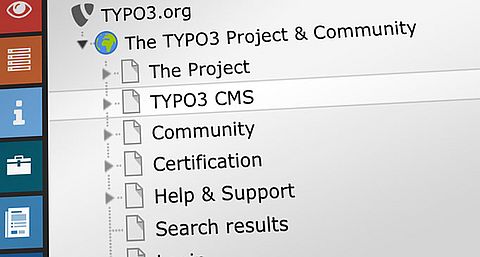The third beta of TYPO3 4.6, scheduled to be released on October 25, was recently made public. This version includes numerous changes, improvements, and innovations, which are documented in the TYPO3 wiki and in the core change log.
TYPO3 4.6 will include features that have been back ported from FLOW3 and TYPO3 Phoenix, such as an updated caching framework and the incorporation of XLIFF support. In addition, new features were added and many improvements were made to overall performance, rendering this version of TYPO3 more powerful for the admins, integrators, and editors who rely on TYPO3 on a daily basis.
TYPO3 4.6: Better Performance, XLIFF, Caching Framework and More
For starters, <link http: forge.typo3.org projects show typo3v4-mvc _blank>Extbase—the modern foundation for extension development and a bridge between TYPO3 Phoenix and TYPO3 version 4—and the <link http: wiki.typo3.org fluid _blank>Fluid templating engine have been brought up to date. The new version of Extbase includes a back-port of FLOW3’s property mapper as well as FLOW3’s implementation of the signal/slot design pattern. Extbase and Fluid also include noteworthy performance improvements. Fluid templates, for example, are now compiled to PHP files, which speeds up the rendering process by a factor of 2 to 5.
The core team has also improved performance throughout the TYPO3 core and these improvements are visible on both the front-end and the back-end. On the TYPO3 back-end, all Javascript files are now concatenated into a single file, which reduces the number of requests to the server by up to 66%. Similarly, in the front-end, concatenation and minification of both Javascript and CSS now takes place on the fly. In TYPO3 4.6, the caching framework, present in the core since TYPO3 4.3, is now activated by default, which allows TYPO3 to take advantage of multiple caches in the back-end. The caching framework accepts a variety of storage back-ends and defaults to the installation’s MySQL database. However, cache data can also be stored in memory by relying on services like<link http: memcached.org _blank>Memcached or <link http: redis.io _blank>Redis.
As in FLOW3, the XML Localization Interchange File Format (XLIFF) is now the standard format for TYPO3 core localization files. These XLIFF files are utilized and generated by the TYPO3 project’s <link http: translation.typo3.org _blank>translation server, which makes it much easier for community members to contribute to the work of translating and localizing the TYPO3 core. There are currently plans in place for converting old LLXML files to the XLIFF format (and vice versa), but this work has not yet been completed.
With new functionality comes new requirements. TYPO3 now requires PHP version 5.3, which was not required for TYPO3 4.5. Moreover, the TYPO3 core no longer includes support for PHP’s <link http: php.net manual de features.safe-mode.php _blank>safe mode. In addition, support for Image Magick versions 4 and 5 has been dropped as well.
A new Form Wizard with ExtJS
One of the most eye-catching innovations in TYPO3 4.6 is the new ExtJS based form wizard, which grew out of the <link http: forge.typo3.org projects typo3v4-form _blank>Form Project. This extension, now the “form” system extension, allows users to easily build forms using a drag and drop interface. A WYSIWYG view simplifies the process of building a form, and relatively non-technical editors can easily add validation rules on a field-by-field basis (eg. email or alphanumeric validation).
With this tool, complex forms can be created quickly and easily, requiring less work than in previous versions of TYPO3. With user TSconfig and page TSconfig, administrators can determine which form wizard elements are available to editors and can configure a form structure that will be used as a starting point for new forms. Site builders and extension developers can take advantage of the TypoScript FORM object to build dynamic forms on the front-end that depend on conditional logic.
Currently the form wizard interface is based on ExtJS version 3.4.0. The core team plans to migrate TYPO3 to ExtJs 4.0 during development of TYPO3 4.7.
Lots of small improvements...
In addition to these larger features, this release contains a number of smaller improvements. For a complete list of all changes, please consult the change log for this release.
- Standard wrap, TypoScript’s swiss army knife, now contains some new helpful new attributes. For example, integrators can now use .round to round floats and .hash for hashing values. StdWrap also now contains random function for picking elements from a list as well as other improvements. TypoScript is the engine that drives TYPO3’s content rendering and standard wrap offers many useful methods for integrators and developers.
- The ENABLE_INSTALL_TOOL file, used in the past to flag access to the install tool, is no longer generated manually. Clicking on the install tool module in the back-end as an administrator will now automatically create this file, which saves admins a few clicks.
- In TYPO3 4.6, it is possible to configure separate CookieNames for the front-end and back-end. This is particularly useful when working with several instances on the same domain.
- There are two new scheduler tasks to help automate site maintenance ad administration. The first task handles garbage collection of files in the paste bin older than a defined number of days. The second task handles garbage collection in the database by removing logging entries after a defined period of time.
- Editors can now set the publishing date for elements using both date and time values, set down to the minute. This was previously not possible due to caching issues and required work-arounds.
- The back-end LoginSecurityLevel is now set to RSA per default.
- Those developers who have not yet switched to Fluid templating can now nestsubparts in TYPO3 templates.
If you are interested in more detailed information about technical changes and new features in TYPO3 4.6, please consult the wiki and changelog as well as the PDF slideshow that Patrick Lobacher (agency owner, author, and TYPO3 certification team member) traditionally publishes for every new TYPO3 release laying out all changes and innovations with a lot of analytic expertise.
What's next? The roadmap for TYPO3 4.6
The <link http: forge.typo3.org projects typo3v46-projects wiki _blank>roadmap for 4.6—which has been faithfully followed during 4.6 development—schedules the first release candidate (RC1) for October and the final release for October 25. As always, the development process is transparent, and we encourage everyone in the community to keep an eye on <link http: forge.typo3.org _blank>forge.typo3.org, where you will find minutes from developer meetings as well as the complete 4.6 roadmap.
Recommended Links concerning TYPO3 Version 4.6:
- <link http: wiki.typo3.org typo3_4.6 _blank>Official wiki for TYPO3 4.6
- <link http: forge.typo3.org projects typo3v46-projects wiki _blank>Version 4.6 at TYPO3-Forge
- <link http: typo3.org download _blank>TYPO3 4.6 beta download (bottom of page)
[German original in T3N magazine: <link http: t3n.de news typo3-46-vorschau-erwartet-euch-neuerungen-328753 _blank in t3n>t3n.de/news/typo3-46-vorschau-erwartet-euch-neuerungen-328753]
article by Sacha Storz, 2011-09-06
proof-reading by Cast Iron Coding




